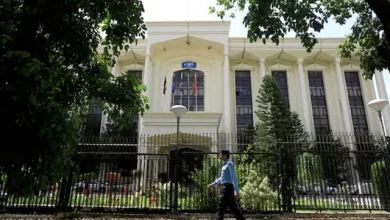Import bill hits $6.1b since March 2022

Trade gap swells by $3.5b in four months as exports decline for third consecutive month
Pakistan’s trade deficit. PHOTO: FILE
ISLAMABAD:
Pakistan’s trade deficit widened to $12.6 billion during the first four months of this fiscal year, an addition of $3.5 billion over the same period last year, after monthly imports spiked to the highest level in over three and a half years.
The Pakistan Bureau of Statistics (PBS) reported on Tuesday that imports in the month of October amounted to $6.1 billion. This was the highest level since March 2022, when the country was about to enter a period of severe economic crisis, followed by harsh stabilisation measures and currency controls. The international trade bulletin released by the PBS showed that the gap between imports and exports reached $12.6 billion during the July-October period. The deficit was $3.5 billion, or 38%, higher than the same period of last fiscal year.
The $3.5 billion additional deficit in four months was equal to half the size of the International Monetary Fund (IMF) loan that the government expects to receive after meeting 50 harsh conditions over three years. Imports during the first four months jumped to $23 billion, up $3 billion, or 15.1%, compared to the same period last year. Imports were also more than double the total value of exports during this period.
The PBS stated that exports, meanwhile, fell to $10.5 billion in four months, down 4% year-on-year. In absolute terms, exports were $440 million less than the same period last year.
One of the reasons behind the spike in imports was lowering duties in the budget. The Federal Board of Revenue (FBR) said that in the first quarter there was a 43% jump in the imports of non-dutiable goods compared to a year ago.
The international trade barriers have been lowered under a combined plan of the government of Pakistan, the World Bank and the IMF. However, last month, the trade expert of the World Bank said that the three-month period was too short to assess the impact of trade liberalisation on the country’s external sector stability.
But the nation’s external sector stability largely hinges on smooth and higher inflows of foreign remittances, as exports continue to lag despite multiple initiatives announced by successive governments over a period. Prime Minister Shehbaz Sharif last month established eight working groups to stop the “complete collapse” of exports, rationalise taxes and energy prices, and revitalise dying industrialisation. Setting up the groups, which will give their reports by mid-month, underscores that the PM also realised the need to kick-start the economy.
Under the IMF programme, the government has committed to cutting import taxes by 52% over a period of five years, with the first phase implemented in July. However, trade liberalisation is not yet supported by an increase in exports, putting the external sector under pressure. Tight import controls until June had eased pressure on Pakistan’s foreign exchange reserves, but unless exports recover in the coming months, the government may have to reconsider its liberalisation policy.
On a year-on-year basis, PBS data showed, exports also decreased to $2.8 billion in October, down $133 million, or 4.5%, from the same month last year. This was the third consecutive month of falling exports, which is now becoming a concern for policymakers and exporters. Imports grew over 20% to $6.1 billion in October. This was the fourth consecutive month when imports stayed above the $5 billion threshold and the first month since March 2022 when they crossed the $6 billion benchmark.
In absolute terms, imports increased $1 billion in a single month, which is equal to the third loan tranche that the IMF may approve in December. As a result, the trade deficit widened 56% to $3.2 billion last month, an increase of $1.2 billion. The PBS data further showed that on a month-on-month basis, the trade deficit contracted 4.2%, but the impact of the $141 million reduction was too little to change the overall picture of the external sector.



